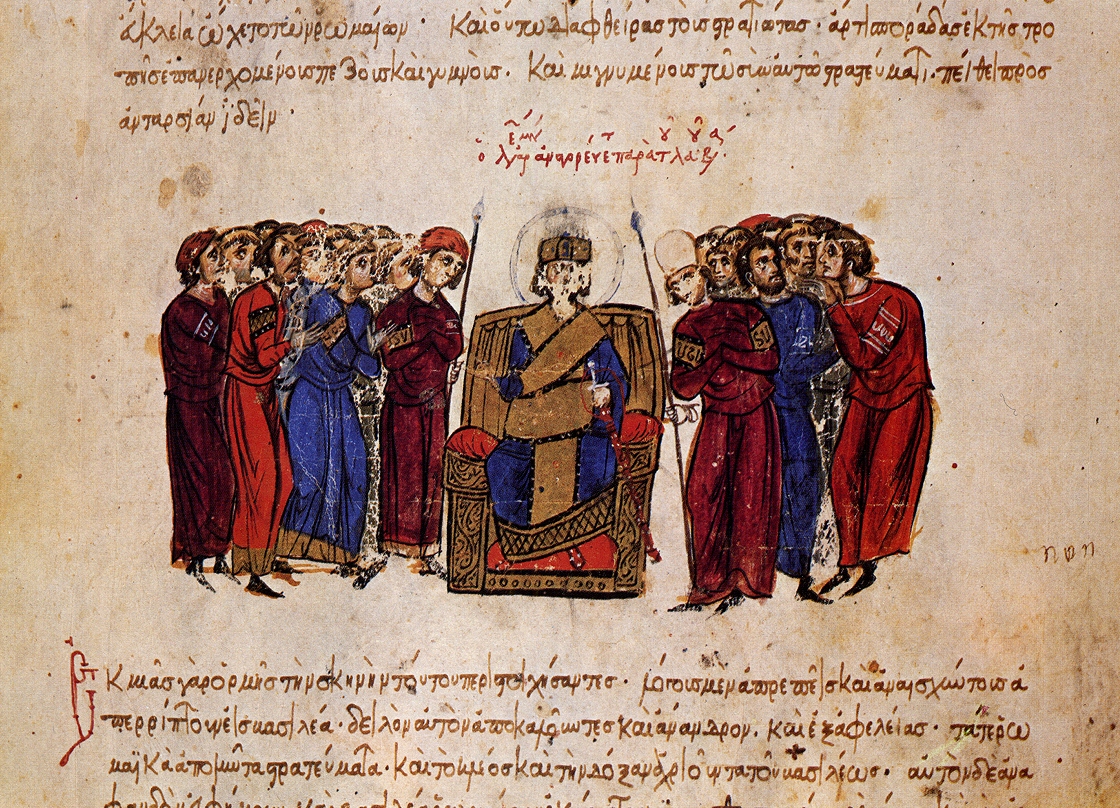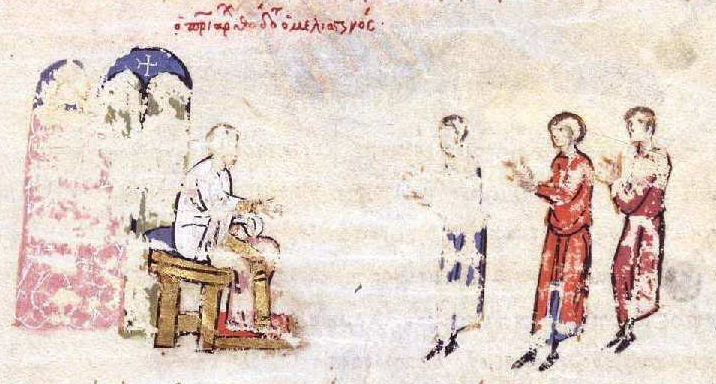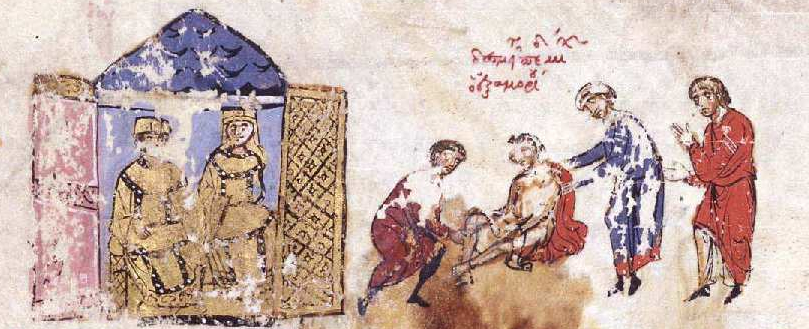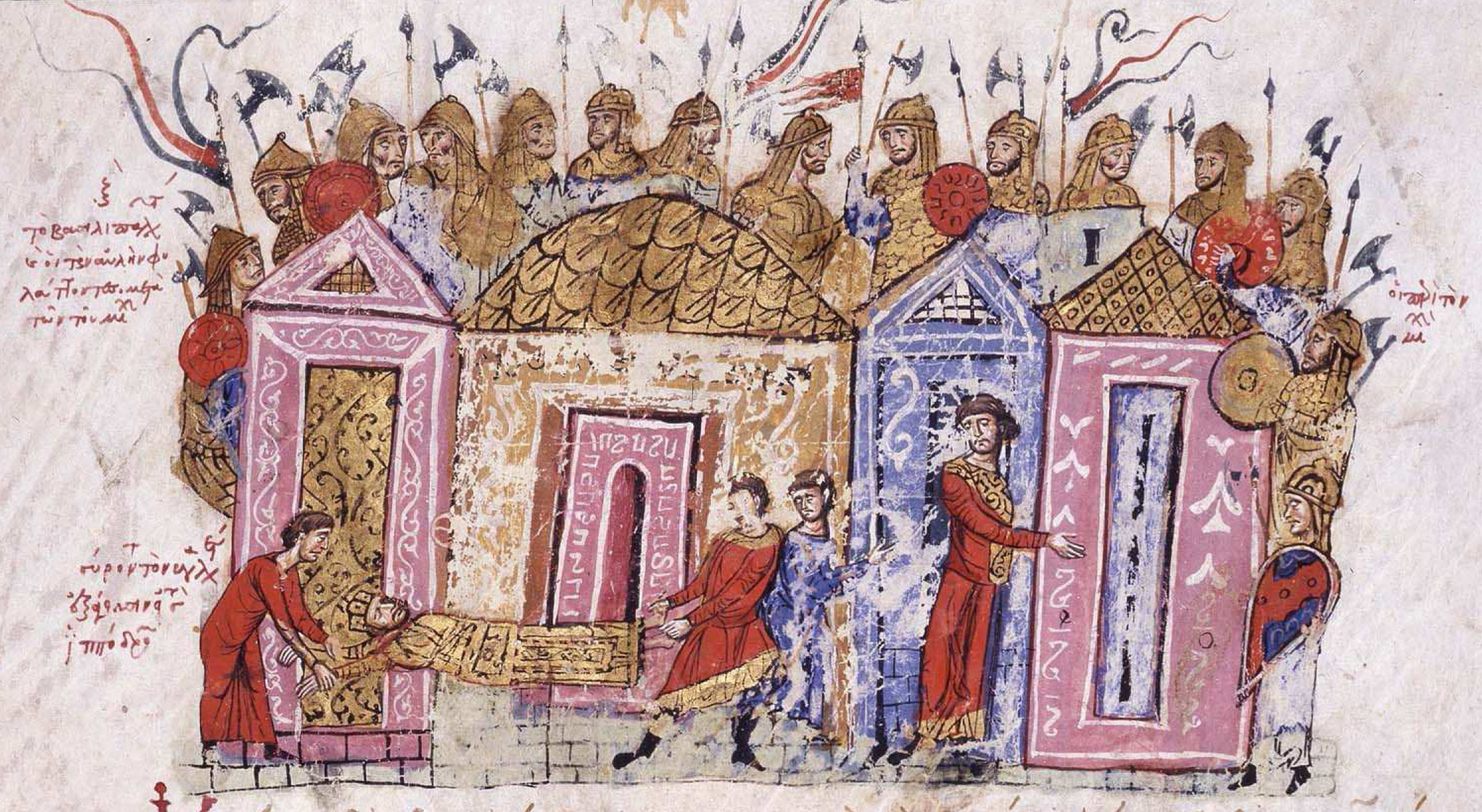Leo The Armenian on:
[Wikipedia]
[Google]
[Amazon]
Leo V the Armenian ( gr, Λέων ὁ ἐξ Ἀρμενίας, ''Leōn ho ex Armenias''; 775 – 25 December 820) was the
 Recalled by
Recalled by  With the
With the  The Emperor used his rather moderate iconoclast policy to seize the properties of iconodules and monasteries, such as the rich
The Emperor used his rather moderate iconoclast policy to seize the properties of iconodules and monasteries, such as the rich  When Leo jailed Michael for suspicion of conspiracy, the latter organized the
When Leo jailed Michael for suspicion of conspiracy, the latter organized the  In the dim light they mistook the officiating priest for the Emperor and the confusion allowed Leo to snatch a heavy cross from the altar and defend himself. He called for his guards, but the conspirators had barred the doors and within a few moments a sword stroke had severed his arm, and he fell before the communion-table, where his body was hewed in pieces. His remains were dumped unceremoniously in the snow and the assassins hurried to the dungeons to free Michael II.
In the dim light they mistook the officiating priest for the Emperor and the confusion allowed Leo to snatch a heavy cross from the altar and defend himself. He called for his guards, but the conspirators had barred the doors and within a few moments a sword stroke had severed his arm, and he fell before the communion-table, where his body was hewed in pieces. His remains were dumped unceremoniously in the snow and the assassins hurried to the dungeons to free Michael II.
 Unfortunately for them Leo had hidden the key on his person, and since it was too early in the morning to find a blacksmith Michael was hastily crowned as emperor with the iron clasps still around his legs. Leo's family (including his mother and his wife, Theodosia) was exiled to monasteries in the
Unfortunately for them Leo had hidden the key on his person, and since it was too early in the morning to find a blacksmith Michael was hastily crowned as emperor with the iron clasps still around his legs. Leo's family (including his mother and his wife, Theodosia) was exiled to monasteries in the
 All known children of Leo V are traditionally attributed to his wife Theodosia, a daughter of the patrician Arsaber.Chris Bennett, "The Relationship of Basil I to Leo V" (1995)
All known children of Leo V are traditionally attributed to his wife Theodosia, a daughter of the patrician Arsaber.Chris Bennett, "The Relationship of Basil I to Leo V" (1995)
/ref> Genesius records four sons: * Symbatios (Συμβάτιος), renamed Constantine, co-emperor from 814 to 820.
Leo V coinage
{{DEFAULTSORT:Leo 05 750s births 820 deaths 8th-century Armenian people 9th-century Armenian people 8th-century Byzantine people 9th-century Byzantine emperors 9th-century murdered monarchs Armenian Byzantine emperors Assassinated Byzantine emperors Byzantine Iconoclasm Deaths by blade weapons Governors of the Anatolic Theme Protostratores 810s in the Byzantine Empire 820s in the Byzantine Empire Byzantine people of Armenian descent
Byzantine emperor
This is a list of the Byzantine emperors from the foundation of Constantinople in 330 AD, which marks the conventional start of the Eastern Roman Empire, to its fall to the Ottoman Empire in 1453 AD. Only the emperors who were recognized as le ...
from 813 to 820. A senior general, he forced his predecessor, Michael I Rangabe
Michael I Rhangabe ( gr, Μιχαὴλ Ῥαγγαβέ; ''c''. 770 – 11 January 844) was Byzantine emperor from 811 to 813.
Michael was the son of the patrician Theophylact Rhangabe, the admiral of the Aegean fleet. He married Prokopia, the ...
, to abdicate and assumed the throne. He ended the decade-long war with the Bulgars
The Bulgars (also Bulghars, Bulgari, Bolgars, Bolghars, Bolgari, Proto-Bulgarians) were Turkic semi-nomadic warrior tribes that flourished in the Pontic–Caspian steppe and the Volga region during the 7th century. They became known as nomad ...
, and initiated the second period of Byzantine Iconoclasm
The Byzantine Iconoclasm ( gr, Εικονομαχία, Eikonomachía, lit=image struggle', 'war on icons) were two periods in the history of the Byzantine Empire when the use of religious images or icons was opposed by religious and imperial a ...
. He was assassinated by supporters of Michael the Amorian
Michael II ( gr, Μιχαὴλ, , translit=Michaēl; 770–829), called the Amorian ( gr, ὁ ἐξ Ἀμορίου, ho ex Amoríou) and the Stammerer (, ''ho Travlós'' or , ''ho Psellós''), reigned as Byzantine Emperor from 25 December 820 to ...
, one of his most trusted generals, who succeeded him on the throne.
Life
Leo was the son of the patrician Bardas, who was ofArmenia
Armenia (), , group=pron officially the Republic of Armenia,, is a landlocked country in the Armenian Highlands of Western Asia.The UNbr>classification of world regions places Armenia in Western Asia; the CIA World Factbook , , and ''Ox ...
n descent (according to Theophanes Continuatus
''Theophanes Continuatus'' ( el, συνεχισταί Θεοφάνους) or ''Scriptores post Theophanem'' (, "those after Theophanes") is the Latin name commonly applied to a collection of historical writings preserved in the 11th-century Vat. g ...
, Leo was also of Assyrian that is Syrian descent). Leo served in 803 under the rebel general Bardanes Tourkos
Bardanes, nicknamed ''Tourkos'', "the Turk" ( gr, Βαρδάνης ὁ Τοῦρκος, Bardanēs ho Tourkos, ), was a Byzantine general of Armenian origin who launched an unsuccessful rebellion against Emperor Nikephoros I () in 803. Although a ...
, whom he deserted in favor of Emperor Nikephoros I
Nikephoros I or Nicephorus I ( gr, Νικηφόρος; 750 – 26 July 811) was Byzantine emperor from 802 to 811. Having served Empress Irene as '' genikos logothetēs'', he subsequently ousted her from power and took the throne himself. In r ...
. The Emperor rewarded Leo with two palaces, but later exiled him for marrying the daughter of another rebel, the patrician Arsaber Arsaber ( el, , from Armenian ''Arshavir''), was a Byzantine noble who attempted an unsuccessful usurpation of the Byzantine imperial throne in 808.
Biography
Arsaber was a noble of Armenian origin, holding the rank of ''patrikios'', and served as ...
. On the other hand, a contemporary source says that one general Leo of the Armeniakon
The Armeniac Theme ( el, , ''Armeniakoi hema'), more properly the Theme of the Armeniacs (Greek: , ''thema Armeniakōi'') was a Byzantine theme (a military-civilian province) located in northeastern Asia Minor (modern Turkey).
History
The Armeni ...
theme was punished for his humiliating defeat by the Arabs during which he also lost the salaries of his thematic units (a modern scholar suggests that this Leo is not the same as the emperor). Punishment also included deprivation of his military rank, beating and hair cutting.
Reign
 Recalled by
Recalled by Michael I Rangabe
Michael I Rhangabe ( gr, Μιχαὴλ Ῥαγγαβέ; ''c''. 770 – 11 January 844) was Byzantine emperor from 811 to 813.
Michael was the son of the patrician Theophylact Rhangabe, the admiral of the Aegean fleet. He married Prokopia, the ...
in 811, Leo became governor of the Anatolic theme and conducted himself well in a war against the Arab
The Arabs (singular: Arab; singular ar, عَرَبِيٌّ, DIN 31635: , , plural ar, عَرَب, DIN 31635: , Arabic pronunciation: ), also known as the Arab people, are an ethnic group mainly inhabiting the Arab world in Western Asia, ...
s in 812, defeating the forces of the Cilician '' thughur'' under Thabit ibn Nasr Thabit ibn Nasr ibn Malik al-Khuza'i () (died 813/14) was an Abbasid general and governor of the Cilician frontier zone ('' al-thughur al-Sha'miya'') with the Byzantine Empire in 808–813.
Thabit was a native of Khurasan, and the grandson of Mali ...
. Leo survived the Battle of Versinikia
The Battle of Versinikia ( bg, Битката при Версиникия; el, Μάχη της Βερσινικίας) was fought in 813 between the Byzantine Empire and the Bulgarian Empire, near the city of Adrianople (Edirne).
While the Bul ...
in 813 by abandoning the battlefield, but nevertheless took advantage of this defeat to force the abdication of Michael I in his favor on 11 July 813. In a diplomatic move, he wrote a letter to Patriarch Nikephoros in order to reassure him of his orthodoxy (Nikephoros being obviously afraid of a possible iconoclast
Iconoclasm (from Greek: grc, εἰκών, lit=figure, icon, translit=eikṓn, label=none + grc, κλάω, lit=to break, translit=kláō, label=none)From grc, εἰκών + κλάω, lit=image-breaking. ''Iconoclasm'' may also be conside ...
revival). One month later, during his entrance to the Palace quarter, he kneeled before the icon of Christ at the Chalke Gate
The Chalke Gate ( el, ), was the main ceremonial entrance (vestibule (architecture), vestibule) to the Great Palace of Constantinople, Great Palace of Constantinople in the Byzantine period. The name, which means "the Bronze Gate", was given to ...
. A further step in preventing future usurpations was the castration of Michael's sons.
With Krum of Bulgaria
Krum ( bg, Крум, el, Κροῦμος/Kroumos), often referred to as Krum the Fearsome ( bg, Крум Страшни) was the Khan of Bulgaria from sometime between 796 and 803 until his death in 814. During his reign the Bulgarian territor ...
blockading Constantinople
la, Constantinopolis ota, قسطنطينيه
, alternate_name = Byzantion (earlier Greek name), Nova Roma ("New Rome"), Miklagard/Miklagarth (Old Norse), Tsargrad ( Slavic), Qustantiniya (Arabic), Basileuousa ("Queen of Cities"), Megalopolis (" ...
by land, Leo V had inherited a precarious situation. He offered to negotiate in person with the invader and attempted to have him killed in an ambush. The stratagem failed, and although Krum abandoned his siege of the capital, he captured and depopulated Adrianople
Edirne (, ), formerly known as Adrianople or Hadrianopolis (Greek: Άδριανούπολις), is a city in Turkey, in the northwestern part of the province of Edirne in Eastern Thrace. Situated from the Greek and from the Bulgarian borders, ...
and Arcadiopolis. When Krum died in spring 814, Leo V defeated the Bulgarians in the environs of Mesembria (Nesebar
Nesebar (often transcribed as Nessebar and sometimes as Nesebur, bg, Несебър, pronounced ) is an ancient city and one of the major seaside resorts on the Bulgarian Black Sea Coast, located in Burgas Province. It is the administrative centr ...
) and the two states concluded a 30-year peace in 815. According to some sources, Krum participated in the battle and abandoned the battlefield heavily injured.
 With the
With the iconodule
Iconodulism (also iconoduly or iconodulia) designates the religious service to icons (kissing and honourable veneration, incense, and candlelight). The term comes from Neoclassical Greek εἰκονόδουλος (''eikonodoulos'') (from el, ε ...
policy of his predecessors associated with defeats at the hands of Bulgarians and Arabs, Leo V reinstituted Iconoclasm
Iconoclasm (from Ancient Greek, Greek: grc, wikt:εἰκών, εἰκών, lit=figure, icon, translit=eikṓn, label=none + grc, wikt:κλάω, κλάω, lit=to break, translit=kláō, label=none)From grc, wikt:εἰκών, εἰκών + wi ...
after deposing patriarch Nikephoros and convoking a synod at Constantinople in 815.
Stoudios Monastery
The Monastery of Stoudios, more fully Monastery of Saint John the Forerunner "at Stoudios" ( grc-gre, Μονή του Αγίου Ιωάννη του Προδρόμου εν τοις Στουδίου, Monē tou Hagiou Iōannē tou Prodromou en to ...
, whose influential iconodule abbot, Theodore the Studite
Theodore the Studite ( grc-x-medieval, Θεόδωρος ό Στουδίτης; 759–826), also known as Theodorus Studita and Saint Theodore of Stoudios/Studium, was a Byzantine Greek monk and abbot of the Stoudios Monastery in Constantinople. H ...
, he exiled. Leo V appointed competent military commanders from among his own comrades-in-arms, including Michael the Amorian
Michael II ( gr, Μιχαὴλ, , translit=Michaēl; 770–829), called the Amorian ( gr, ὁ ἐξ Ἀμορίου, ho ex Amoríou) and the Stammerer (, ''ho Travlós'' or , ''ho Psellós''), reigned as Byzantine Emperor from 25 December 820 to ...
and Thomas the Slav
Thomas the Slav ( gr, Θωμᾶς ὁ Σλάβος, Thōmas ho Slavos, – October 823) was a 9th-century Byzantine Empire, Byzantine military commander, most notable for leading a wide-scale revolt in 821–23 against Byzantine emperor, E ...
. He also persecuted the Paulicians
Paulicianism (Classical Armenian: Պաւղիկեաններ, ; grc, Παυλικιανοί, "The followers of Paul"; Arab sources: ''Baylakānī'', ''al Bayāliqa'' )Nersessian, Vrej (1998). The Tondrakian Movement: Religious Movements in the ...
.
 When Leo jailed Michael for suspicion of conspiracy, the latter organized the
When Leo jailed Michael for suspicion of conspiracy, the latter organized the assassination
Assassination is the murder of a prominent or important person, such as a head of state, head of government, politician, world leader, member of a royal family or CEO. The murder of a celebrity, activist, or artist, though they may not have ...
of the Emperor in the palace chapel of St. Stephen on Christmas Eve
Christmas Eve is the evening or entire day before Christmas Day, the festival commemorating the birth of Jesus. Christmas Day is observed around the world, and Christmas Eve is widely observed as a full or partial holiday in anticipation ...
, 820. Leo was attending the matins service when a group of assassins disguised as members of the choir due to sing in the service suddenly threw off their robes and drew their weapons.
 In the dim light they mistook the officiating priest for the Emperor and the confusion allowed Leo to snatch a heavy cross from the altar and defend himself. He called for his guards, but the conspirators had barred the doors and within a few moments a sword stroke had severed his arm, and he fell before the communion-table, where his body was hewed in pieces. His remains were dumped unceremoniously in the snow and the assassins hurried to the dungeons to free Michael II.
In the dim light they mistook the officiating priest for the Emperor and the confusion allowed Leo to snatch a heavy cross from the altar and defend himself. He called for his guards, but the conspirators had barred the doors and within a few moments a sword stroke had severed his arm, and he fell before the communion-table, where his body was hewed in pieces. His remains were dumped unceremoniously in the snow and the assassins hurried to the dungeons to free Michael II.
 Unfortunately for them Leo had hidden the key on his person, and since it was too early in the morning to find a blacksmith Michael was hastily crowned as emperor with the iron clasps still around his legs. Leo's family (including his mother and his wife, Theodosia) was exiled to monasteries in the
Unfortunately for them Leo had hidden the key on his person, and since it was too early in the morning to find a blacksmith Michael was hastily crowned as emperor with the iron clasps still around his legs. Leo's family (including his mother and his wife, Theodosia) was exiled to monasteries in the Princes' Islands
The Princes' Islands ( tr, Prens Adaları; the word "princes" is plural, because the name means "Islands of the Princes", el, Πριγκηπονήσια, ''Pringiponisia''), officially just Adalar ( en, Islands); alternatively the Princes' Arch ...
. His four sons (including ex co-emperor Symbatios) were castrated, a procedure so brutally carried out that one of them died during the "operation".
Even sources vehemently hostile to Leo (Theophanes Continuatus, Patriarch Nikephoros) acknowledge his competence in managing state affairs. Unfortunately, as with all iconoclast emperors, his actions and intentions cannot be easily reconstructed due to the extreme bias of the iconodule sources (there are no surviving contemporary iconoclast sources of any kind).
Children
 All known children of Leo V are traditionally attributed to his wife Theodosia, a daughter of the patrician Arsaber.Chris Bennett, "The Relationship of Basil I to Leo V" (1995)
All known children of Leo V are traditionally attributed to his wife Theodosia, a daughter of the patrician Arsaber.Chris Bennett, "The Relationship of Basil I to Leo V" (1995)/ref> Genesius records four sons: * Symbatios (Συμβάτιος), renamed Constantine, co-emperor from 814 to 820.
Castrated
Castration is any action, surgical, chemical, or otherwise, by which an individual loses use of the testicles: the male gonad. Surgical castration is bilateral orchiectomy (excision of both testicles), while chemical castration uses pharmaceut ...
and exiled following the assassination of his father.
* Basil. Castrated and exiled following the assassination of his father. Still alive in 847, recorded to have supported the election of Patriarch Ignatius of Constantinople
St. Ignatius or Ignatios ( el, Ιγνάτιος), (c. 798 – 23 October 877) was a Patriarch of Constantinople from July 4, 847, to October 23, 858, and from November 23, 867, to his death on October 23, 877. In the Catholic Church and Eas ...
.
* Gregory. Castrated and exiled following the assassination of his father. Still alive in 847, recorded to have supported the election of Patriarch Ignatius of Constantinople
St. Ignatius or Ignatios ( el, Ιγνάτιος), (c. 798 – 23 October 877) was a Patriarch of Constantinople from July 4, 847, to October 23, 858, and from November 23, 867, to his death on October 23, 877. In the Catholic Church and Eas ...
.
* Theodosios (died in 820). Died soon after his castration.
* Anna, who married Hmayeak, a Mamikonian prince (died c. 797), by whom she had Konstantinos, an officer at the court of Emperor Michael III.Koushagian, Torkom. ''Saints & Feasts of the Armenian Church''. Translated by Haigazoun Melkonian. (2005), p. 5, New York: Diocese of the Armenian Church of America (Eastern).
Possible descendants
Nicholas Adontz
Nicholas Adontz (, ''Nikoghayos Adonts’'', also spelled Adonts; ; January 10, 1871 – January 27, 1942) was an Armenian historian, specialist of Byzantine and Armenian studies, and philologist. Yuzbashyan, Karen. s.v. Adonts', Nikoghayos G ...
in his book ''The age and origins of the emperor Basil I'' (1933) expressed a theory that Leo V and Theodosia were ancestors of Basil I
Basil I, called the Macedonian ( el, Βασίλειος ὁ Μακεδών, ''Basíleios ō Makedṓn'', 811 – 29 August 886), was a Byzantine Emperor who reigned from 867 to 886. Born a lowly peasant in the theme of Macedonia, he rose in the ...
. The theory was partly based on the account of his ancestry given by Constantine VII
Constantine VII Porphyrogenitus (; 17 May 905 – 9 November 959) was the fourth Emperor of the Macedonian dynasty of the Byzantine Empire, reigning from 6 June 913 to 9 November 959. He was the son of Emperor Leo VI and his fourth wife, Zoe Kar ...
, a grandson of Basil I, as well as the accounts given by Theophanes Continuatus. Basil I, according to these accounts, was a son of peasants. His mother is named by Constantine VII as "Pankalo". The name of his father was not recorded, but the names Symbatios and Constantine have been suggested; both were names used by the eldest sons of Basil, with eldest sons of Byzantines typically named after their grandfathers. The paternal grandfather of Basil is named as Maiactes. The paternal grandmother was not named but was identified as a daughter of "Leo", a citizen of Constantinople
la, Constantinopolis ota, قسطنطينيه
, alternate_name = Byzantion (earlier Greek name), Nova Roma ("New Rome"), Miklagard/Miklagarth (Old Norse), Tsargrad ( Slavic), Qustantiniya (Arabic), Basileuousa ("Queen of Cities"), Megalopolis (" ...
. Adontz identified this Leo as Leo V, which would make Leo V and Theodosia great-grandparents of Basil I. Adontz also suggested Constantine VII had made a mistake in the generations separating Maiactes and Basil. This suggests that Basil was a great-grandson of Maiactes and not old enough to have seen the wars with Krum of Bulgaria
Krum ( bg, Крум, el, Κροῦμος/Kroumos), often referred to as Krum the Fearsome ( bg, Крум Страшни) was the Khan of Bulgaria from sometime between 796 and 803 until his death in 814. During his reign the Bulgarian territor ...
, which would make Leo V and Theodosia fourth-generation ancestors of Basil.
The theory has been accepted by several genealogists, including Christian Settipani
Christian Settipani (born 31 January 1961) is a French genealogist, historian and IT professional, currently working as the Technical Director of a company in Paris.
Biography
Settipani holds a Master of Advanced Studies from the Paris-Sorbo ...
in his search for descent from antiquity
In European genealogy, a descent from antiquity (DFA or DfA) is a proven unbroken line of descent between specific individuals from ancient history and people living today. Descents can readily be traced back to the Early Middle Ages, but beyond ...
. The name "Anna" has been suggested for the daughter of Leo V and Theodosia, because it was given to daughters of Basil I
Basil I, called the Macedonian ( el, Βασίλειος ὁ Μακεδών, ''Basíleios ō Makedṓn'', 811 – 29 August 886), was a Byzantine Emperor who reigned from 867 to 886. Born a lowly peasant in the theme of Macedonia, he rose in the ...
, Leo VI the Wise
Leo VI, called the Wise ( gr, Λέων ὁ Σοφός, Léōn ho Sophós, 19 September 866 – 11 May 912), was Byzantine Emperor from 886 to 912. The second ruler of the Macedonian dynasty (although his parentage is unclear), he was very well r ...
, Constantine VII
Constantine VII Porphyrogenitus (; 17 May 905 – 9 November 959) was the fourth Emperor of the Macedonian dynasty of the Byzantine Empire, reigning from 6 June 913 to 9 November 959. He was the son of Emperor Leo VI and his fourth wife, Zoe Kar ...
and Romanos II
Romanos II Porphyrogenitus ( gr, Ρωμανός, 938 – 15 March 963) was Byzantine Emperor from 959 to 963. He succeeded his father Constantine VII at the age of twenty-one and died suddenly and mysteriously four years later. His son Bas ...
--almost every emperor that would claim descent from this woman.
See also
*List of Byzantine emperors
This is a list of the Byzantine emperors from the foundation of Constantinople in 330 AD, which marks the conventional start of the Eastern Roman Empire, to its fall to the Ottoman Empire in 1453 AD. Only the emperors who were recognized as le ...
References
*''TheOxford Dictionary of Byzantium
The ''Oxford Dictionary of Byzantium'' (ODB) is a three-volume historical dictionary published by the English Oxford University Press. With more than 5,000 entries, it contains comprehensive information in English on topics relating to the Byzant ...
'', Oxford University Press, 1991.
*
External links
Leo V coinage
{{DEFAULTSORT:Leo 05 750s births 820 deaths 8th-century Armenian people 9th-century Armenian people 8th-century Byzantine people 9th-century Byzantine emperors 9th-century murdered monarchs Armenian Byzantine emperors Assassinated Byzantine emperors Byzantine Iconoclasm Deaths by blade weapons Governors of the Anatolic Theme Protostratores 810s in the Byzantine Empire 820s in the Byzantine Empire Byzantine people of Armenian descent